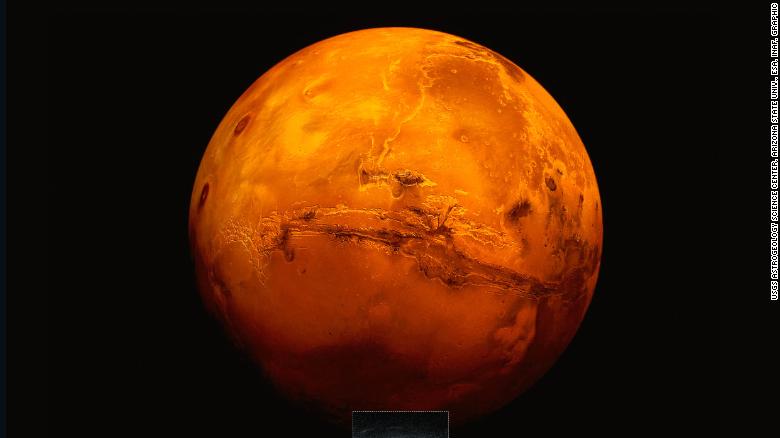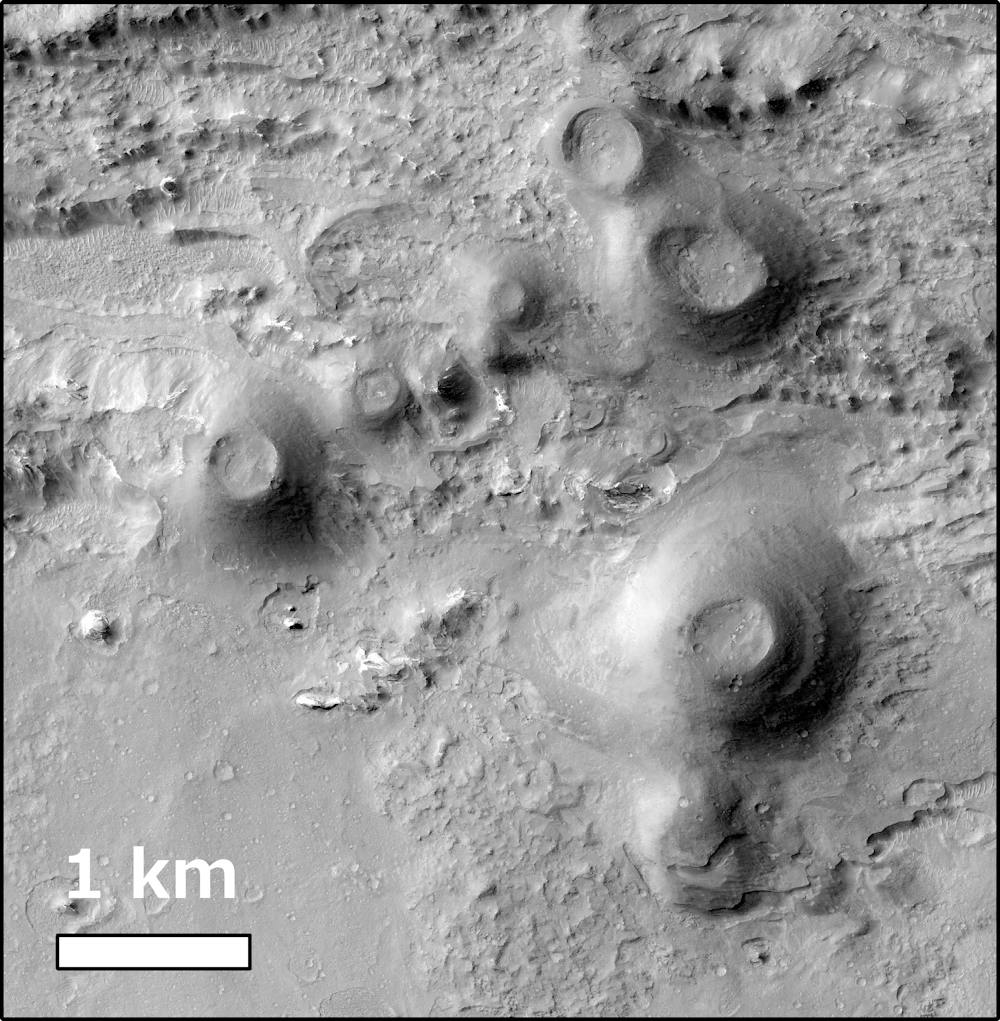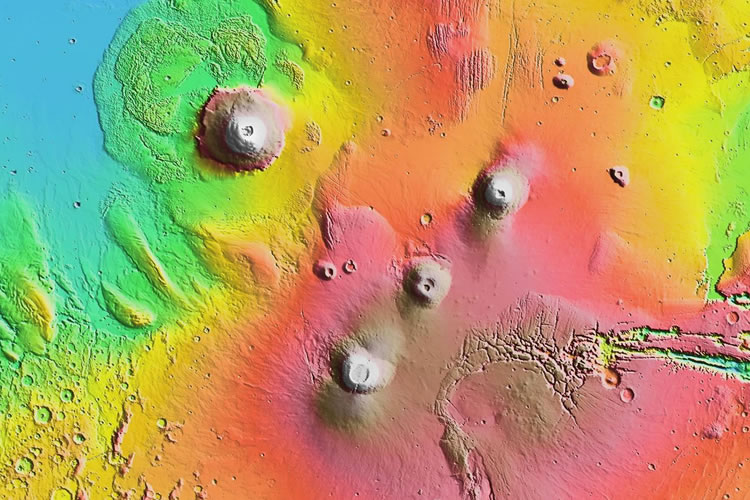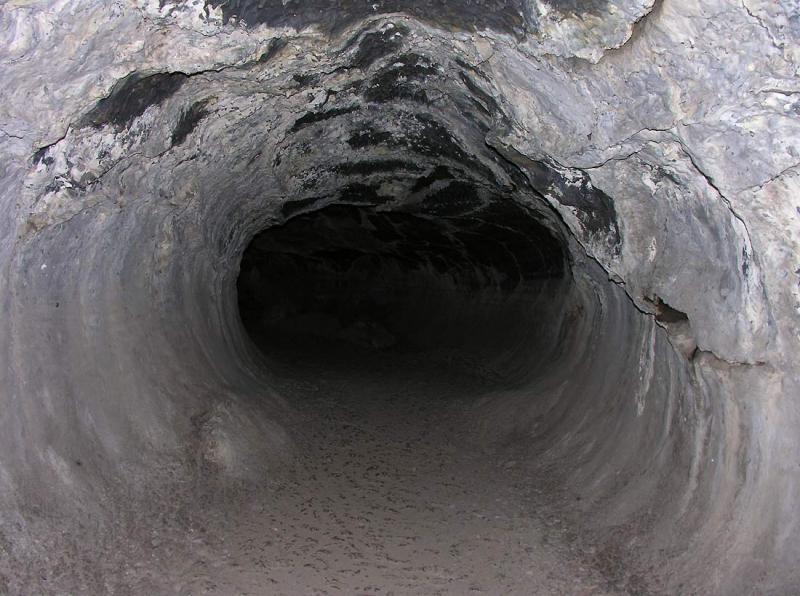The Potential for Microbial Life as a Result of Volcanic Activity
Joel Zaidan, Addison Dewar, DiDi McDonald, Nathan Pidperyhora, Calvin Taylor
Introduction

Mars’ surface contains a vast variety of volcanic regions. These volcanoes played a major role in forming Mars’ atmosphere in the past. Mars maintains an oxidizing atmosphere, making it difficult for the formation of life. However, previous volcanic activity on Mars may have helped in creating a reducing, anoxic atmosphere resembling, the early atmosphere of Earth.1 This early atmosphere on Mars may have provided the fundamental gases needed for the formation of microbial life.1. We will be discussing the various volcanic regions on Mars and give details on how these volcanoes formed. Giving the geological features of Mars helps to give readers an idea of the magnitude and effect that volcanic activity played in shaping Mars atmosphere. We will also be discussing how we know that volcanic activity occurred in the past on Mars and the effects of this activity in shaping Mars atmosphere. Finally, we will explore the topic of volcanic tunnels and the potential for life in these tunnels on Mars. Our main thesis for the project will be, how do we know volcanic activity shaped the early atmosphere on Mars and how did Mars’ early atmosphere have the potential to host microbial life.
Geological Features on Mars
The Tharsis Dome on Mars is home to the largest volcanoes in the solar system. It includes three enormous shield volcanoes, the Arsia Mons, Pavonis Mons, and Ascraeus Mons.2 The Tharsis Dome is 4000km across and rises to 10km in height. Olympus Mons is the largest volcano in the solar system, almost entirely constructed of basalt lava flows. It stands 26km above the surrounding plains and is 600km wide at its base, making it almost as large as France. New Nasa research reveals that the giant Martian shield volcano produced one new lava flow at its summit every 1-3 million years during the final peak of activity. The last volcanic activity there ceased about 50 million years ago.2 Arsia Mons was built up over billions of years, though details of its lifecycle are still being worked out. The oldest flows on Mars date back to 200 million years ago.

Arsia Mons
https://www.space4case.com/mmw/pages/space4case/mars/mars-images-20032.php
The biggest difference between Martian and terrestrial volcanoes is its size. The volcanoes in the Tharsis region on Mars are 10-100x larger than volcanoes on Earth.2 They were built from large magma chambers that are deep within the Martian crust. The Martian flows are also much longer. This is most likely due to larger eruption rates and due to lower gravity on Mars.2 One of the reasons volcanoes of such magnitude were able to form on Mars is because the hot volcanic regions in the Mantle remained fixed relative to the surface for hundreds of millions of years.2 On the other hand, on Earth, volcanoes are formed when the tectonic plates shift beneath the Earth’s crust. The flow of tectonics below the crust across the hot volcanic regions prevents large volcanoes from forming. For example, the Hawaiian Islands were created as the Pacific plate moved Northwest.2 These volcanoes have a relatively short lifetime. As the plate moves, new volcanoes form while the old ones become silent.
Lava flows on Mars are much longer and thicker than typical basalt lava flows on Earth. Smithsonian scientists are studying some of the largest lava flows on Earth to better understand what might cause these differences and what they mean for the physical processes affecting volcanic eruptions on Mars.2 Based on measurements on shadow length, a large lava flow near Arsia Mons, was determined to have an average lava flow 100m thick. One significance of lava flow on Mars is that in the past some lava eruptions likely occurred where ice lay close to the surface. The magma would melt the ice, releasing clouds of steam and possibly floods of water.3 Water is of the utmost importance when talking about the formation and sustainability of life. The release of water from the ice through lava flow increased the chances of the formation of microbial life among the surface of Mars.
Young Volcanoes on Mars

There are still volcanoes forming on Mars. Researchers have previously spotted various clusters of small young “cones” – symmetrical hills with summit craters – but their origin has always been controversial4. They could be true sites of a volcanic eruption, but they could equally well be “mud volcanoes” formed by the expulsion of mud from below ground or “rootless cones” formed by explosions caused by lava flowing across wet or icy ground4. In 2017 a scientific team studied young cones in Coprates Chasma, the deepest part of Mars’s Valles Marineris canyon system on Mars. This is far from Mars’ main volcanic regions and suggests that magma has erupted from the interior though ancient but reactivated fractures in the canyon system. Counting crater impact dates these cones from 200-400 million years old. The cones were built by explosive eruption of clots of lava from a central vent, growing the cone slowly layer by layer until reaching its final height4. Each cone’s surface may be “armour-plated” because these clots hit the ground still hot enough to partially weld together and protect it. This could account for their fresh appearance, in contrast to mud volcanoes, which would be more vulnerable to erosion. These findings are important as volcanism this young on Mars suggest there’s still some volcanic activity on the planet and that there may still be volcanoes forming today. This research is significant as volcanic activity is the main reason for Mars’ atmosphere to be reducing/anoxic in the past. A reducing atmosphere is needed for the formation of microbial life.
So far, the team have obtained compositional information from just one of the cones using MRO’s Compact Reconnaissance Imaging Spectrometer for Mars (CRISM). This revealed the presence of a mineral called opaline silica as well as sulfate minerals. This suggests that the hot rocks, whether before or after an eruption, reacted with Martian ground water4.
If this is the case, each volcano may have hosted a suitable mixture of water, warmth and chemical energy to support microbial life like the kind that inhabits hot springs on Earth4. The cones studied are unlikely to host life today as they are over 200 million years old. However, would be good targets to search for fossilised microbes.

Meteorite Analysis
Despite careful observations by earth- and space-based telescopes, no eruptive activity has ever been recorded on Olympus Mons. However, contrary to the data mentioned about Arsia Mons, there is relatively new evidence suggesting that Olympus Mons may still be an active volcano3. Crater counts from high-resolution images taken by the Mars Express orbiter in 2004 indicated that lava flows on the northwestern flank of Olympus Mons range in age from 115 to only 2 million years or less, this is very young in geologic terms3. This was the first clue suggesting that the volcano may still be active. The next clue came from NASA´s recent mission to Mars. NASA launched the Curiosity rover on November 26, 2011, which landed on Mars on August 6, 20123. The Curiosity rover was able to analyze rock samples on Mars and compare their composition to rocks found on Earth. This led to the discovery that certain meteorites found in Antarctica originated from Mars. Recently a meteorite was discovered in Antarctica that had a seemingly fresh impact site along with similar features to that of a volcanic bomb – solidified lava ejected during strong eruptions3. The chemical composition of the meteorite revealed it had come from Mars, later determined to have come from Olympus Mons on Mars. Mars is on average approximately 140 million miles (225 million km) from Earth. Meteorites need to travel approximately 2 miles/hour to reach planetary space from Mars. Therefore, at an average speed of 2 miles/s, a volcanic bomb erupted from Mars would have to travel at least about 800 days, or little more than 2 years to reach Earth3. However, this only applies if the bomb travels along a direct trajectory, which is very unlikely to be the case. Most often, the trajectory before a collision with Earth would involve several round-trips on elliptic paths, which would increase the time of travel by a factor of up to 20. This means that the bomb could have travelled through space for decades after the eruption on Mount Olympus before reaching Earth. Although we don’t know the precise date, geologists can now be sure that the last eruption of Mt. Olympus occurred at some time in the 20th century, and that the volcano is still Active! The importance of active volcanoes is the release of essential gases are necessary for the creation and sustainment of organic life.
Volcanic Tunnels
Picture from: https://2015.spaceappschallenge.org/challenge/survivor-mars-lava-tubes/

According to research, there are many sources that give evidence that mars will be the planet that space expedition with taking humans to live another planet. Articles, videos and NASA sites research that there will be more orbiters and robotics studying the landscapes, geography and the possibility of life on Mars. Although we are still a long way away, they are also simulations of the living conditions of Mars to help us adapt to the changes that are expected. Many of my research indicates the underground lava tubes is what they will use to help support life for the extreme weather of continuous dust storms and the radiation4. Planetary explorers are discussing building bases on Mars, using the underground caverns called lava tubes are becoming more ideal for explorers to build for their future expeditions. Based on the information collected from current robotics such as the Mars rovers, they are still gathering data based on the landscape formations of mars “Lava tubes can form in two ways: over-crusted tubes form when low-viscosity lava flows fairly close to the surface, developing a hard crust that thickens to create a roof above the moving lava stream. When the eruption’s end, the conduit is drained leaving a tunnel a few metres beneath the surface. “Inflated’ tubes are complex and deep structures that form when lava is injected into existing fissures between layers of rock or cavities from previous flows. The lava expands and leaves a huge network of connected galleries as it forces its way to the surface5.” Technology is advancing that they are now testing and using simulations of the extreme weather conditions for future missions so they can have greater chances of survival. Although they can’t fully determine the real effects of actual mars conditions and the effects that would come from living on a different planet. Adaptation and advancements on Mars would take a very long time for living conditions and resources for survival. Lava tubes are said to provide the perfect shelter from the harsh weather such as dust storms and radiation because the lava flows made a protective barrier that would keep out outside extremes and possibly contain and store air6. Based on the evidence on earth’s lava tubes it is theoretically possible to build small cities within those tubes. According to space staff, the NASA orbiter GRAIL will be used to measure the size and depths of lava tubes through the surface openings called skylights5. They are also working on robotics that is so small that they will be used to cover more of the Mars surface using a honeybee technique7. Unlike the rovers, they will be able to go further distances and in different directions which took the rover months to cover. Due to the complications of the sand ruining and building up mars dust which make sit more difficult to gather data7. It is also that volcanic tunnels not only possible based on captured images from skylights captured by orbiters but I also think the volcanic tubes are associate Olympus Mons with Tharis Mons. That the volcanic tubes from Olympus are possibly linking underground caverns to Arisa, Pavonis and Ascraeus Mons.
Mars Early Atmosphere
Mars current atmosphere is oxidizing, dominated by the photochemistry of CO2 and H2O. Mars experienced widespread volcanism in the past and these volcanic emissions would have included reducing gases, such as H2 and CO, as well as sulfur-bearing gases. Scientists were able to use a one-dimensional photochemical model to determine whether volcanic gases could have switched the redox-state of the past Martian atmosphere to reducing conditions8. The total quantity and proportions of volcanic gases depend on the water content, outgassing pressure, and oxygen fugacity of the source melt. It was found that, with reasonable melt parameters, the past Martian atmosphere could have easily reached reducing and anoxic conditions with moderate levels of volcanism, which are well within the range of estimates from thermal evolution models and photogeological studies8. These results imply that ancient Mars should have experienced periods with anoxic and reducing atmospheres even through the mid-Amazonian whenever volcanic outgassing was sustained at high enough levels. Reducing anoxic conditions give potential to the synthesis of prebiotic organic compounds such as amino acids. Amino acids are a precursor to life and therefore with the synthesis of amino acids gives the possibility of life on Mars. Also, anoxic reducing conditions should have influenced the type of minerals that were formed on the surface or deposited from the atmosphere. For example, elemental polysulfur (S8) deposits are a signature of past reducing atmospheres. Current models allow us to estimate the amount of volcanically sourced atmospheric sulfate deposited over Mars’ history8. This was determined to be approximately ∼106–109 Tmol, with a spread depending on assumed outgassing rate history and magmatic source conditions8. This is further evidence that Mars previously had a reducing atmosphere, capable of providing the fundamental gases needed to create and support microbial life. These reducing, anoxic conditions have been hypothesized as being important to the origin of life on the early Earth.
He pointed out that the famous Urey-Miller experiments of the 1950s showed that electrical pulses, in an environment with a reducing atmosphere and liquid water, produced complex organic molecules. By contrast, an oxidizing atmosphere would also oxidize these molecules, making them less useful in supporting the formation of life. A reducing atmosphere on Mars is significant as it has been found that there was previously water on the surface of Mars. This water combined with a reducing atmosphere, created from volcanic activity has the possibility of producing microbial life on Mars.

Miller Urey experiment
Conclusion
Considering the early atmosphere on Mars along with the volcanic activity, there is a chance that in the past Mars had the possibility of sustaining microbial life. The history of volcanic activity known by scientists displays that there has been volcanic activity in the past and potentially still today – releasing essential gases needed to play host to microbial life forms. Previous experiments such as the Miller Urey experiment have shown that several organic compounds such as amino acids, critical to the formation of life, can be formed spontaneously by stimulating the condition of an early reducing atmosphere9. Scientists have further identified clusters of cones which are likely young volcanoes forming. These young volcanoes are a likely host for microbial life, providing gas release, mixture of water, chemical energy, and warmth for the support of microbial life. Lastly, lava tubes from ancient volcanoes on Mars makes it possible to stay out of the dust storms and harsh atmosphere on the surface. This would provide a suitable location for the growth of Microbial life. Many of the factors mention lead to the conclusion that Mars was capable of hosting microbial life in the past, due to volcanic activity.
Work Cited
- NeuroImage (2017). Anoxic Atmospheres on Mars Driven by Volcanism. Accessed February 10th, 2019. https://www.sciencedirect.com/science/article/abs/pii/S0019103516300756
- Hamilton, C. (2019). Martian Volcanoes. [online] Solarviews.com. Available at: http://solarviews.com/eng/marsvolc.htm [Accessed 28 Feb. 2019].
- Siegfied, C. (2015, April 1). Mount Olympus. Retrieved from https://www.volcanodiscovery.com/mars/olympus-mons/evidence-of-recent-volcanic-activity.html
- Lava tubes as hidden sites for future human habitats on the Moon and Mars. Phys.org – News and Articles on Science and Technology.
https://phys.org/news/2017-09-lava-tubes-hidden-sites-future.html#jCp
- Howell, E. (2017, April 07). Volcanic Activity on Ancient Mars May Have Produced Organic Life. Retrieved March 01, 2019, from https://www.seeker.com/space/planets/volcanic-activity-on-ancient-mars-may-have-produced-organic-life
- Mars Astronomy. CrashCourse, YouTube (2015).
- si.edu. (2019). Mars Lava Flows | Exploring the Planets | National Air and Space Museum. [online] Available at: https://airandspace.si.edu/exhibitions/exploring-the-planets/online/solar-system/mars/surface/volcanoes/lava-flows.cfm [Accessed 28 Feb. 2019].
- Future robotic exploration using honeybee search strategy: Example search for caves on Mars. Á. Kisdi and A.R. Tatnall, Acta Astronautica 68, 1790 (2011).
- Mars Caves and Lava Tubes. S.P.A.C.E. Staff, Space.com (2012). https://www.space.com/18519-mars-caves-lava-tubes-photos.html